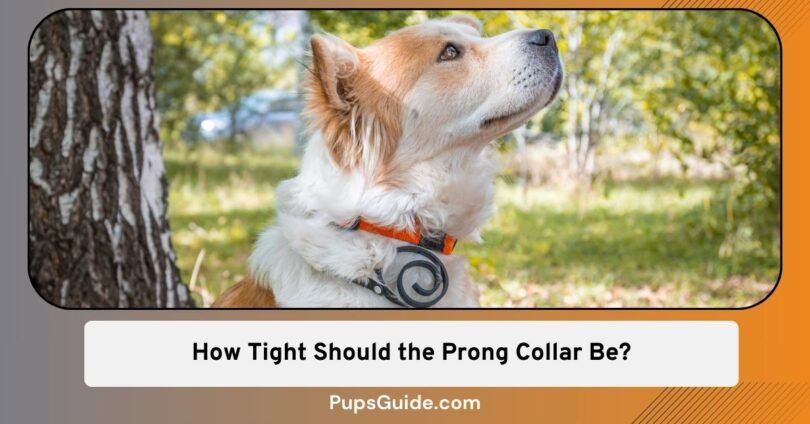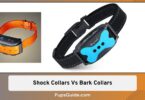Wondering about the right fit for prong collars? Think of it like finding the perfect slice of pizza – controversial, but with potential.
Used correctly, prong collars can be your dog’s training ally. But, the real magic lies in getting that collar to snugly fit your furry friend. Stick around, and let’s break down the dos and don’ts of prong collar fitting.
Summary: The collar should be snug around the dog’s neck. It shouldn’t roam free but be tied up high under the dog’s chin and behind those adorable ears. It’s not a fashion show; it’s about function. No draping over the head – secure it behind the ears for a snug fit that won’t disappear.
4 Things To Consider With A Prong Collar Besides Tightness
The tightness of a prong collar is a crucial aspect of using it. Read on to know what else can you do to nail the size.
Getting the Size Right Because It Matters
Many dog parents mess up by grabbing a prong collar that’s not the right size. If it slips on your pup’s neck smoother than butter on a biscuit, that’s a red flag.
Size matters, my friends. Forget onesizefitsall. Take the example of a 70-pound Belgian Malinois that I trained – his sweet spot? A small 2.25 millimeter collar – lighter, smaller, and ready for correction. When sizing up your pup, channel your inner dog expert and aim for the right fit.
Beware of Bargains or Cheap Ones
Thinking of snagging a sale collar? Hold your horses. Run your fingers along those prongs like you’re picking the best fruit at the market. Polished ends are key. Cheap collars might seem like a steal, but they’re more likely to be rough around the edges, causing harm instead of charm.
Avoid sale regrets – invest in quality.
Positive Corrections Only in Training
Conditioning your pooch to the prong collar is like introducing them to a new BFF. Treats, treats, treats – the key to a pup’s heart.
When that collar shows up, feed him a treat. Positive reinforcement turns that pinch collar into a symbol of good times. Your dog with years of collar wisdom ahead will know that it’s a treat bonanza every time that metal buddy shows up.
Safety First: Backup Plans Are Cool
We’re all about safety. Adding a backup plan is like having a spare tire – you hope you never need it, but it’s a lifesaver when things go sideways. Connect a choke chain or martingale as the wingman to your prong collar. If the prong collar decides to go rogue, the backup ensures you’re still the puppet master.
What Are The Signs That A Prong Collar Is Too Tight On Your Dog?
Making sure your pup is comfy and safe is a top priority when rocking a prong collar. Spot these signs that indicate that the collar might be giving your dog a tight squeeze.
1. Panting
Huffing and puffing after you’ve tied the collar on your dog is a telltale sign of breathing difficulties as a result of a tight collar. Give him some space – the collar should let him breathe.
2. Scratching
Your dog scratching at the collar is a red flag. A too-tight collar can turn into an itchy, scratchy nightmare. Keep an eye out for signs of irritation – no one likes a scratchy situation.
3. Restlessness
Is your chill dog suddenly channeling inner restlessness? It might be the prong collar causing discomfort.
4. Resisting Wearing It
Does your dog avoid you during the collar time? It may show signs of disapproval whenever you bring the collar in plain sight. Dogs usually associate collars with positive vibes. A sour face is a signal that something’s amiss.
5. Ignoring Commands
Discomfort or anxiety from a too-tight fit could be the reason for the silence.
6. Swelling
Swelling or bruising around the neck? That’s a big no-no. The collar’s meant to be a control device, not a cause for a neck puff-up. Regular check-ins on the neck zone are a must – any signs of swelling mean it’s time for collar triage.
7. Whining And Yelping
If your dog’s serenade turns into a yelping or whining symphony when the prong collar’s on, it’s a clear SOS. The collar shouldn’t be a pain playlist. Adjustments are in order to keep the harmony – and your dog’s vocal cords – intact.
8. Excessive Pulling
Excessive pulling, resistance, or general discomfort might be the collar acting up. A well-fitted prong collar should be your helper, not the wrestling opponent.
9. Difficulty Eating and Drinking
Your dog will experience difficulty eating or drinking. A prong collar should never mess with a pup’s meal mojo.
When Should You Use Prong Collars?
Deciding to slap a prong collar on your buddy isn’t a casual move; it needs some thought and should fit specific situations. When handled right, this tool can be handy in certain scenarios. Let’s break down when it might be the right call:
1. Reeling in the Overzealous Walker
Got a leash that feels more like a tug-of-war rope? A prong collar can be your go-to. It’s like giving your dog a gentle nudge, mirroring how a momma dog nudges her pups – firm but without the fuss.
2. Big and Brawny Breeds
Training hefty hounds, like Belgian Malinois or other powerhouse pooches, can be a workout. The prong collar is a heavyweight contender in training sessions for those robust breeds that don’t yield to a regular collar or harness.
3. Command Schooling
When your dog’s working on his manners, like walking beside you or mastering the art of “come,” the prong collar steps up to be the communication champ. It’s a direct line to your dog, making corrections a breeze during training sessions.
4. Behavioral Hiccups
For the troublemakers displaying aggression or being a tad too reactive, a prong collar, wielded by a savvy handler, becomes the training superhero. But remember, call in the pros – a.k.a., a dog trainer or behavior guru – to train your dog well.
5. Safety Dance for Handlers
If you’re not an Olympic weightlifter and find it a challenge to manage a powerhouse or a reactive dog, the prong collar plays bodyguard. It’s an extra layer of control, ensuring both you and your furry sidekick stay out of harm’s way.
6. Collar Confusion Transition
Some dogs play hard to get with regular collars or harnesses, making walks a wrestling match. In this case, the prong collars allow the smooth transitioning of your buddy into a new comfort zone. Just remember the golden rule – positive reinforcement and treats should make up a good case here.
How Tight Should the Prong Collar Be? In a Nutshell
The prong collar, when done right, is a game-changer in dog training. Nail the sizing as I showed in the intro, choose quality, shower your pup with treats, and you’ve got a dog training sidekick that won’t let you down.
It’s not just a collar; it’s a bond builder. Get it right, and you and your dog will enjoy a harmonious relationship.








Leave a Comment